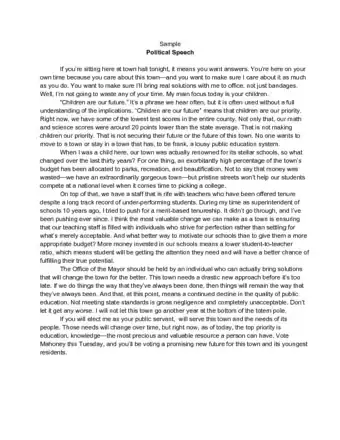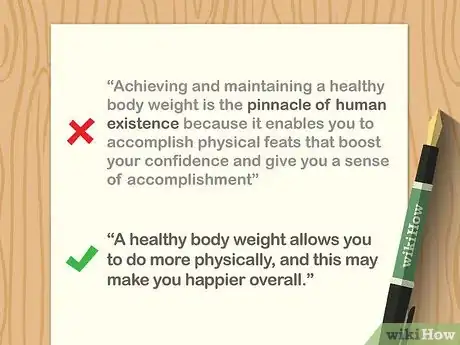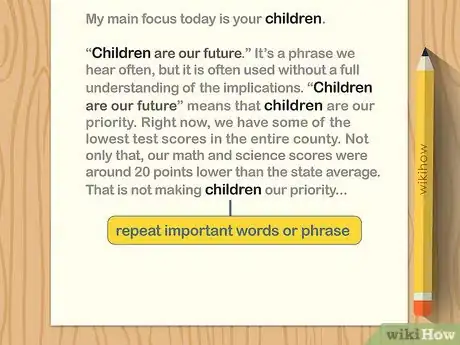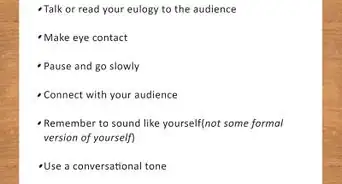This article was co-authored by Patrick Muñoz. Patrick is an internationally recognized Voice & Speech Coach, focusing on public speaking, vocal power, accent and dialects, accent reduction, voiceover, acting and speech therapy. He has worked with clients such as Penelope Cruz, Eva Longoria, and Roselyn Sanchez. He was voted LA's Favorite Voice and Dialect Coach by BACKSTAGE, is the voice and speech coach for Disney and Turner Classic Movies, and is a member of Voice and Speech Trainers Association.
There are 7 references cited in this article, which can be found at the bottom of the page.
wikiHow marks an article as reader-approved once it receives enough positive feedback. This article has 22 testimonials from our readers, earning it our reader-approved status.
This article has been viewed 2,935,559 times.
Giving an original speech for a class, event, or work presentation can be nerve-wracking. However, writing an effective speech can help to bolster your confidence. With careful planning and an eye for detail, you can write a speech that will inform, persuade, motivate, or entertain! Give yourself plenty of time to craft your speech and practice it several times for best results.
Steps
Sample Speeches
Drafting an Effective Speech
-
1Research your topic well. If you are writing an informative or persuasive speech, then it should be very well researched! This will help to give you credibility and make your points far more convincing. Seek out scholarly sources, such as books, academic journals, newspaper articles, and government websites to find information and support for your claims.[1]
- If you are writing a speech for a class, make sure to check with your teacher to get details about the number and acceptable types of sources.
-
2Make an outline that includes your main argument and points. Organizing your ideas and research into an outline is a great way to check for completeness and flow before you actually draft the speech.[2] In general, a speech should include an introduction, 5 main points with supporting evidence (such as statistics, quotes, examples, and anecdotes), and a conclusion. Use a numbered structure or simply outline your speech using bullet points.[3]
- If you are writing an informative or persuasive speech, then plan to arrange your speech with a problem and solution structure. Start the speech by talking about what is wrong, then explain how to fix the problem in the second half of your speech.[4]
Tip: Keep in mind that you can always refine your outline later or as you draft your speech. Include all of the information that seems relevant now with the expectation that you will likely need to pare it down later.
Advertisement -
3Choose a hook to grab the audience’s attention right away. The opening line of a speech may be the most important part because this is when your audience will decide if they want to keep listening or not. Depending on your topic and your goals for the speech, you can start by saying something funny, sad, frightening, or shocking to hook your audience.[5]
- For example, if you are writing a motivational speech about weight loss, then you might say something like, “Five years ago, I could not walk up a flight of stairs without needing to take a break halfway up.”
- If you hope to persuade audience members to reduce their use of fossil fuels, then you might start off by saying, “Gas-powered vehicles are the reason why global warming is threatening to destroy our planet.”
-
4Connect your topic to a larger issue to give background information. Depending on how niche your topic is, your audience may not feel its relevance unless you explain it to them. This is crucial because if the topic seems irrelevant to your audience, then they are unlikely to pay much attention. Think about the big picture and how your topic fits into it. Why should the people in your audience care about this topic?[6]
- For example, if you are giving a speech on increasing funding for Alzheimer’s research, it would be helpful to provide information on how common Alzheimer’s disease is and how it affects families. You could accomplish this with a combination of a statistic and an anecdote.
Tip: Keep your introduction less than 1 paragraph or 1 double-spaced page long. This will help to ensure that you do not spend too much time on the context and background before getting to the meat of your topic.[7]
-
5Address each of your main points in a logical order. After introducing your topic and providing context, launch right into your points. State each point clearly and offer additional information, evidence, facts, and statistics to explain each of your points.[8] Plan to devote about 1 paragraph to each of your points.[9]
- For example, in a speech about ending animal testing for cosmetics, you might start with a point about how animal testing is cruel, then explain that it is unnecessary, and then talk about the alternatives to animal testing that make it obsolete.
-
6Introduce new topics and summarize material you have already covered.[10] Another way to help your audience understand the points you are making is to provide a brief 1 to 2 sentence overview before you move onto a new topic and then summarize the material in 1 to 2 sentences after you finish explaining it. Put the previews and summaries in plain, simple terms to help make your points clear to your audience.[11]
- For example, if you are about to cover the concept of delayed onset muscle soreness (also known as DOMS), then explain what it is in a nutshell first, then go into more detail about it and how it relates to your point, then end that section of your speech with a brief summary of the main point you are trying to make.
-
7Include transitions to guide your audience through your speech. Transitions improve the flow of your speech and help readers see how your points are connected. You may not notice transitions when you read or write something, but when they are not included a piece of writing will seem choppy and awkward. Check to make sure that you have included transitions throughout your speech. Some common transition words and phrases include:[12]
- Then
- Next
- Before
- After
- First
- Second
- In that moment
- The following week
-
8Conclude your speech with a call-to-action. As you near the end of your speech, your audience should be excited by your topic and ready to act. Encourage your audience to find out more and participate in a solution to the problem you have described by telling them how they can do so. This is a great opportunity to share resources with your audience and to give them some direction for how they can participate.[13]
- For example, if you have just described the effects of global warming on the polar bear population, conclude your speech by telling your audience about non-profit organizations that are working to protect the environment and the polar bear population.
- If you have just shared your weight loss story to motivate your audience, tell them what they can do to start their own weight loss journey and share resources that you found helpful.
Making Your Speech More Engaging
-
1Keep your words and sentences short and simple. Using big words when simpler ones will express the same meaning may alienate your audience. Likewise, long, complex sentences can be confusing and muddle your point. Stick to simple language for the bulk of your speech. Only use complex words or phrases if there is no other way to express the ideas.[14]
- For example, instead of saying, “Achieving and maintaining a healthy body weight is the pinnacle of human existence because it enables you to accomplish physical feats that boost your confidence and give you a sense of accomplishment,” say, “A healthy body weight allows you to do more physically, and this may make you happier overall.”
- Keep in mind that it is also important to vary your sentence structure. You can include a longer sentence once or twice per page to add variety to your speech. Just avoid using lots of long sentences in your speech.[15]
-
2Favor nouns over pronouns for clarity. It’s okay to use the occasional pronoun, especially if doing so will help you to avoid repeating yourself multiple times. However, using too many pronouns can make it hard for your audience to follow your argument and keep track of what you are talking about. Opt for proper nouns (names of places, people, and things) whenever possible and avoid overusing pronouns. Some common pronouns include:[16]
- it
- he
- her
- they
- we
- that
- those
-
3Repeat a word or phrase a few times during your speech. Repetition is a powerful element of speech writing. While too much repetition in any piece of writing can be distracting, repeating a word or phrase a few times during your speech can help to crystallize your argument and keep your audience engaged.[17]
- For example, if you are giving a speech for a group of sales associates who are trying to increase sales of a new product called “Synergy,” then you might repeat a simple phrase to that effect, such as “Tell your customers about Synergy,” or you could simply say, “Synergy” a few times during your speech to remind your audience of this product.
- If you are writing a motivational speech about how running can help people to overcome emotional hurdles, then you might repeat a phrase in your speech to emphasize this idea, such as, “Run through the pain.”
-
4Limit statistics and quotes to avoid overwhelming your audience. It may seem like providing tons of statistics and quotes by experts is a sure way to make a convincing argument, but it often has the opposite effect. Limit yourself to only 1 or 2 statistics or quotes per point and only include stats and quotes that are truly meaningful.[18]
- For example, if you are giving a speech about moose mating patterns, 2 numbers that show the decline in the moose population over a 50 year period may be a striking addition to your speech. However, sharing a complex set of moose population statistics would be less compelling and possibly even confusing to your audience.
- Choose quotes that are easy to follow and make sure that you explain how each quote you use supports to your argument. Try to stick with quotes that use simple language and take up no more than 2 lines on your page.
-
5Maintain an appropriate tone throughout your speech. The tone is the overall mood of your speech, which can range from serious to upbeat, or humorous to urgent. Your choice of words and the way you deliver the speech will affect the tone of your speech.[19]
- For example, when describing your love of food in a motivational speech about becoming a chef, you might decide to include a joke and say something like, “I always wanted to become a chef, ever since I was a little kid and I discovered that people actually make donuts and they don’t just randomly fall from the sky.”
-
6Provide visual aids if you are allowed. Having a PowerPoint presentation is not a requirement for a good speech, but it can help your audience members to follow along, especially if you have some complex points to make. You can also use slides to provide visual representations of your main points, such as by projecting pictures, pie charts, and quotes.[20]
- Avoid relying on the slides to make the speech for you. You will still need to deliver your speech in an engaging manner. Only use the slides as a complement to your words.
-
7Practice and check for weak spots that you can improve. Once you have finished writing your speech, read through it several times to practice it and identify areas that you can strengthen. If you need to keep your speech within a set time limit, then time yourself as you read.[21]
- Make sure to read your speech out loud when you review it! This will help you to determine if it sounds natural and if there are any awkward sections that you can cut, smooth out, or explain more clearly.[22]
- Ask a friend or family member to listen to you deliver your speech and give you feedback on it before you deliver it.[23]
Expert Q&A
Did you know you can get expert answers for this article?
Unlock expert answers by supporting wikiHow
-
QuestionHow do you practice giving a speech?
 Patrick MuñozPatrick is an internationally recognized Voice & Speech Coach, focusing on public speaking, vocal power, accent and dialects, accent reduction, voiceover, acting and speech therapy. He has worked with clients such as Penelope Cruz, Eva Longoria, and Roselyn Sanchez. He was voted LA's Favorite Voice and Dialect Coach by BACKSTAGE, is the voice and speech coach for Disney and Turner Classic Movies, and is a member of Voice and Speech Trainers Association.
Patrick MuñozPatrick is an internationally recognized Voice & Speech Coach, focusing on public speaking, vocal power, accent and dialects, accent reduction, voiceover, acting and speech therapy. He has worked with clients such as Penelope Cruz, Eva Longoria, and Roselyn Sanchez. He was voted LA's Favorite Voice and Dialect Coach by BACKSTAGE, is the voice and speech coach for Disney and Turner Classic Movies, and is a member of Voice and Speech Trainers Association.
Voice & Speech Coach
-
QuestionCan you start a speech with a question?
 Community AnswerA question is a great way to start a speech. Follow up the question with some facts that prove your argument, then conclude your speech by answering the question you started with.
Community AnswerA question is a great way to start a speech. Follow up the question with some facts that prove your argument, then conclude your speech by answering the question you started with. -
QuestionHow should I start a speech?
 Community AnswerStart with an interesting line that will catch your audience's attention or surprise them. This will make you more approachable and your speech more relatable. It will draw your audience in and keep them captivated.
Community AnswerStart with an interesting line that will catch your audience's attention or surprise them. This will make you more approachable and your speech more relatable. It will draw your audience in and keep them captivated.
References
- ↑ http://teacher.scholastic.com/writewit/speech/tips.htm
- ↑ Patrick Muñoz. Voice & Speech Coach. Expert Interview. 12 November 2019.
- ↑ https://www.write-out-loud.com/howtowritespeech.html
- ↑ http://teacher.scholastic.com/writewit/speech/tips.htm
- ↑ https://www.academicwritingsuccess.com/7-sensational-essay-hooks/
- ↑ https://writingcenter.unc.edu/tips-and-tools/speeches/
- ↑ https://www.unr.edu/writing-speaking-center/student-resources/writing-speaking-resources/speech-introductions
- ↑ Patrick Muñoz. Voice & Speech Coach. Expert Interview. 12 November 2019.
- ↑ https://writingcenter.unc.edu/tips-and-tools/speeches/
- ↑ Patrick Muñoz. Voice & Speech Coach. Expert Interview. 12 November 2019.
- ↑ https://writingcenter.unc.edu/tips-and-tools/speeches/
- ↑ https://writingcenter.unc.edu/tips-and-tools/speeches/
- ↑ https://writingcenter.unc.edu/tips-and-tools/speeches/
- ↑ http://teacher.scholastic.com/writewit/speech/tips.htm
- ↑ https://pac.org/content/speechwriting-101-writing-effective-speech
- ↑ https://writingcenter.unc.edu/tips-and-tools/speeches/
- ↑ https://writingcenter.unc.edu/tips-and-tools/speeches/
- ↑ https://writingcenter.unc.edu/tips-and-tools/speeches/
- ↑ https://writingcenter.unc.edu/tips-and-tools/speeches/
- ↑ https://pac.org/content/speechwriting-101-writing-effective-speech
- ↑ https://writingcenter.unc.edu/tips-and-tools/speeches/
- ↑ http://teacher.scholastic.com/writewit/speech/tips.htm
- ↑ Patrick Muñoz. Voice & Speech Coach. Expert Interview. 12 November 2019.
About This Article
To write a speech, start off with an attention-grabbing statement, like "Before I begin my speech, I have something important to say." Once you've gotten everyone's attention, move on to your strongest argument or point first since that's what audiences will remember the most. Use transitions throughout your speech, like "This brings us back to the bigger picture," so the audience doesn't get lost. To conclude your speech, restate the key points and leave your audience with a question or something to think about. To learn how to edit your first draft, scroll down!
















































































